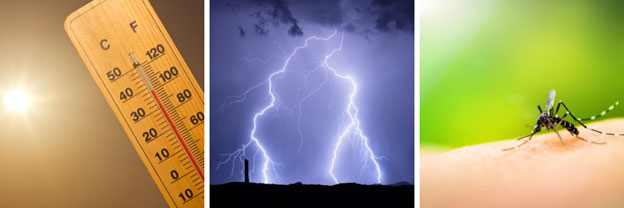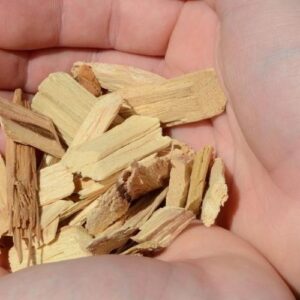
As all pet owners know, a yard is used by all members of the family – including the pets! Everyone benefits from time outdoors, and that’s no different for our furry, feathered, or scaly friends. Unfortunately, there are many threats to outdoor pets in the Phoenix area, making a pet-friendly landscape essential to anyone whose pets venture out into the yard.
While most families with a dog think of fences and those with a tortoise think of areas for their pet to burrow, there are several other considerations to keep in mind to keep your pets safe and to avoid costly veterinary bills.
In this article, we cover some of the potential hazards that can be found on Phoenix-area properties, as well as simple ways to avoid harm to your pets. You’ll learn about the dangers of:
- Spikes, thorns, and other painful parts of plants and trees,
- Toxic plants, trees, and seeds,
- Fertilizers and pesticides,
- Heat and weather dangers,
- Wild animals and other wildlife,
- And more!

Spiky Plants, Trees, Cactus, and Seeds Can Injure Pets
Most plants grown in the Southwest have some kind of spikes or thorns to protect themselves. While humans can learn to avoid these dangers, they can cause injuries to a variety of pets.
One of the sneakiest kinds of spikes is on a weed called goat head or puncture vine. This invasive plant creates seeds that are so sharp they can cut into pet paws and even cause flat tires (pictured on the right). If you have any kind of animal that likes to graze, these seeds can cause injuries around the animal’s mouth.
Dogs tend to avoid any plants with thorns or spikes such as cacti, roses, or trees. However, when you are out for walks or hikes, you may want to invest in covers for your dog’s feet. During hikes or when otherwise out in the desert, dogs are more likely to encounter foxtails, burs, and cactus spines.
If your dog does end up walking over thorns or getting too close to a cactus, here’s how to remove cactus thorns from a dog’s paw.
Note that any bur, thorn, or spike can lead to an infection, so disinfect the wound and keep an eye on it.

Toxic Plants, Trees, And Seeds Can Be Deadly
Despite their beauty, some plants are best kept at a distance. Some of the most common toxic plants for pets found in the Phoenix area are:
- Oleander
- Lantana
- Mesquite pods
- Castor beans
For a more complete list, the ASPCA has lists of toxic and non-toxic plants for dogs, cats, and horses.
Keep these plants out of your yard, particularly if your pet is prone to chewing on things.
Signs of ingesting toxic plants can include:
- Vomiting
- Diarrhea
- Colic
- Excessive thirst
- Convulsions
- Other symptoms
If you think that your pet has eaten or chewed on any of those plants or seeds, bring them to a veterinarian as soon as possible – within the hour is best.

Fertilizers and Pesticides Can Transfer to Pets
If you use gardening products such as plant food, fertilizer, or pesticides, check the labels for warnings regarding exposure or ingestion by humans and animals.
These items can easily end up in a water dish or can just as easily transfer onto a pet’s fur. Later, when the pet licks its fur, it can unintentionally consume the product.
Along with using pet-friendly products, you can also ensure that pets stay away from anything that was recently fertilized or sprayed, wipe their paws down, and empty, clean, and refill any water bowls consistently.
Symptoms of Fertilizer or Pesticide Poisoning in Pets
Similar to the signs that a pet has eaten a toxic plant, symptoms of fertilizer or pesticide poisoning can include:
- Vomiting
- Diarrhea
- Colic
- Excessive thirst
- Convulsions
- Other symptoms

Dangerous Heat or Weather Systems to Watch For
It’s no exaggeration to say that Phoenix has some of the hottest summer months in the country, so precautions need to be made for pets just as for any other member of the family.
Dogs can easily burn their paws if the ground is too hot. A way to test this is to put the back of your hand on any paved or hardscaped areas (wherever the dog will walk) for 7 seconds. If it’s too hot for the back of your hand, it’s too hot for your pet’s paws.
If your pet spends any time outside during the summer months, ensure it is receiving enough water. Provide shade and/or indoor time whenever possible. Shade cloth, pergolas and ramadas, leafy trees, and large shrubs can all give pets some welcome relief from the sun.
Know the Signs of Heat Exhaustion in Your Pets
If you notice vomiting, diarrhea, lack of coordination, or excessive drooling or panting, your pet is probably suffering from excessive heat exposure. Heat exhaustion can impact older or overweight cats and dogs more than young or fit pets, but it can affect all animals (and humans too!) if exposed to the elements long enough.
Heat exhaustion can escalate into heatstroke, which can cause seizures, fainting, loss of consciousness … or worse.
Monsoon Dangers for Pets
Our summers are also filled with monsoon storms that can include violent winds, downpours, hail, flash flooding, and other dangers. Be sure there are no items in your yard that could be blown at your pet by a strong wind gust and keep animals away from low-lying areas on your property that might be prone to flooding.
The monsoons also bring out mosquitos, which can transfer disease to pets. Ticks can be found in some areas nearby, so it’s important to keep up on preventative care, such as flea and tick medication.
Avoid Harming Pets in Cold Weather
And let’s not forget that cold days (and nights) can impact animals, too. In fact, freezing temperatures can be fatal for animals that are outdoors. Anything below 32 degrees Fahrenheit is considered unsafe, and temperatures below 20 degrees Fahrenheit carry the risk of hypothermia and/or frostbite. Pets in Southern Arizona aren’t used to the extreme cold, so bringing them indoors is always the best option to keep them safe.
Protect your pets during cold weather by:
- Not leaving them outside when possible
- Keeping your pets hydrated and well-fed
- Providing shelter for outdoor pets/farm animals and checking that their water bowls aren’t frozen over
- Provide smaller or short-haired dogs with a jacket or sweater for extra warmth

Desert Wildlife Live Here Too
A variety of desert wildlife is found throughout the greater Phoenix area, and some can harm or kill your pets.
Javelinas have been known to attack and injure dogs. Mountain lions, coyotes, and bobcats will often steal smaller pets from backyards, never to be seen again. Rattlesnakes are venomous and extreme care should be taken to keep pets away from them to avoid snake bites. Even scorpions can cause injury if they consider themselves in danger. And Sonoran desert toads, which appear during the monsoon seasons, have poison glands that kill more dogs in the Phoenix area than rattlesnake bites do.
These and other animals and pests can pose a danger to your pets, even while they are in your yard. Keep vigilant and watch (and listen!) for any dangers, especially after nightfall.
There are unique outfits that pets can wear to protect them from some animals, training courses to keep them away from rattlesnakes, and sprays that can keep some pests away. But it’s still best to stay aware whenever your pets are outdoors.
Don’t store any pet food outdoors (that will just invite wildlife into your yard) and remember that most forms of wildlife found in our area can scale large walls or fences.
When hiking, use a shorter (6-foot) leash to keep dogs out of wooded areas and tall grasses, where animals tend to hide.
Prevention is Always Preferable
In all the above instances, it is always better to plan ahead and prevent any issues rather than spending time and money on large veterinary bills. Check your plants and trees to see if they are toxic to your pets, watch for wildlife, be careful with what products you use in your yard and garden, and keep an eye on the temperature and weather conditions when your pets are outdoors.
See Our Latest Articles
More Articles Like This

Titan Tree Care is a full-service tree care company located in Anthem, AZ and serving all of North Phoenix. We offer a wide range of services to meet your tree care needs, including tree and palm trimming, tree pruning, tree removal, stump grinding, and more. We also offer insect or disease treatments and fertilization services. We are dedicated to providing high-quality, safe, and effective tree care services to our customers and work hard to ensure that your trees are healthy and look their best.









